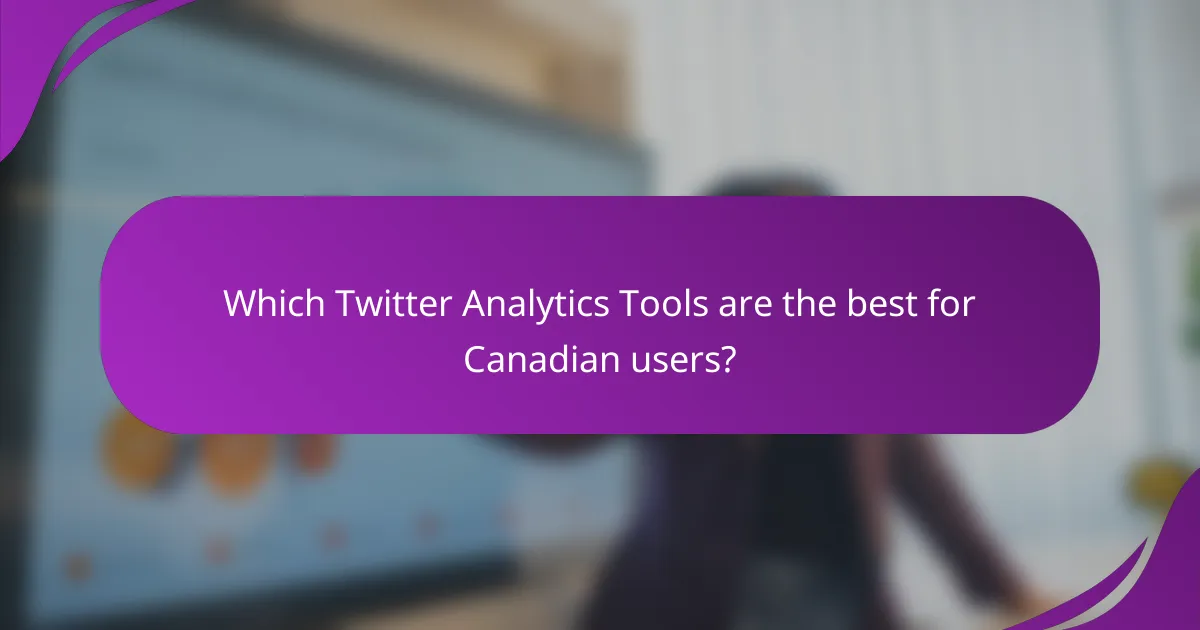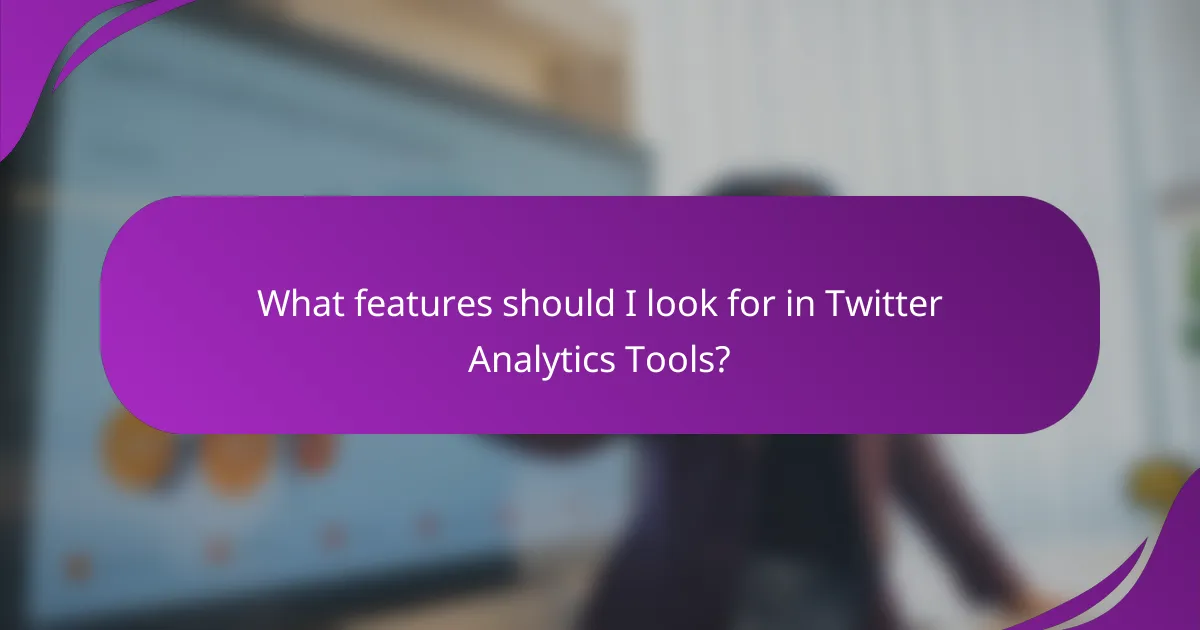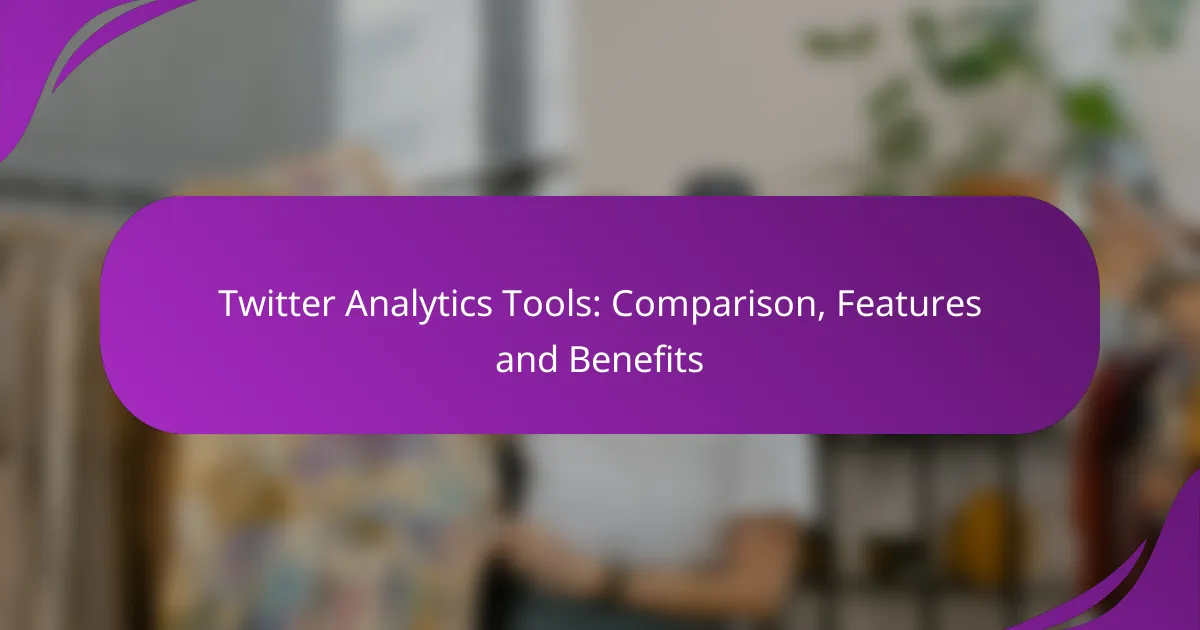Twitter analytics tools are essential for Canadian users looking to enhance their social media strategies through detailed insights into engagement and audience demographics. With options like Hootsuite Analytics and Sprout Social, businesses can leverage user-friendly interfaces and robust features to optimize their content performance and improve customer engagement.

Which Twitter Analytics Tools are the best for Canadian users?
For Canadian users, the best Twitter analytics tools offer comprehensive insights into engagement, audience demographics, and content performance. Tools like Hootsuite Analytics and Sprout Social stand out due to their user-friendly interfaces and robust features tailored for the Canadian market.
Hootsuite Analytics
Hootsuite Analytics provides detailed reports on Twitter performance, including metrics like follower growth, engagement rates, and post reach. Its integration with other social media platforms makes it a versatile choice for users managing multiple accounts.
Canadian users can benefit from Hootsuite’s localized insights, allowing them to tailor their content strategies based on regional trends. The platform offers customizable dashboards, making it easy to track specific metrics that matter most to your audience.
Sprout Social
Sprout Social is known for its powerful analytics capabilities, offering in-depth reports on audience engagement and content performance. It allows users to analyze tweet performance over time, helping to identify what resonates with followers.
For Canadian users, Sprout Social provides insights into local audience behavior, which can inform targeted marketing strategies. The tool also features a user-friendly interface and robust scheduling options, making it ideal for businesses looking to optimize their Twitter presence.
TweetDeck
TweetDeck is a free tool that allows users to manage multiple Twitter accounts and monitor real-time engagement. While it lacks advanced analytics features, it provides a straightforward way to track tweets, mentions, and hashtags.
Canadian users can utilize TweetDeck for immediate feedback on their posts, making it a great option for those who prioritize real-time interaction over detailed analytics. It’s particularly useful for monitoring events or campaigns as they unfold.
Twitter Analytics
Twitter Analytics is the platform’s built-in tool, offering essential metrics such as tweet impressions, engagement rates, and audience demographics. It’s a straightforward option for users looking to understand their performance without additional costs.
For Canadian users, Twitter Analytics provides insights into local audience engagement, helping to refine content strategies. While it may not offer the depth of third-party tools, it serves as a solid starting point for those new to analytics.
Buffer Analyze
Buffer Analyze focuses on simplifying social media analytics, providing users with easy-to-understand reports on Twitter performance. It highlights key metrics like engagement and reach, helping users identify successful content types.
Canadian users can leverage Buffer Analyze to streamline their reporting processes and gain insights into their audience’s preferences. Its user-friendly interface and integration with Buffer’s scheduling tools make it a practical choice for businesses looking to enhance their Twitter strategy.

What features should I look for in Twitter Analytics Tools?
When selecting Twitter analytics tools, focus on features that provide actionable insights into your account’s performance. Key aspects include real-time data tracking, engagement metrics, follower demographics, and content performance analysis to help optimize your strategy.
Real-time data tracking
Real-time data tracking allows you to monitor your Twitter activity as it happens, providing immediate insights into how your tweets are performing. This feature is crucial for understanding audience reactions and adjusting your content strategy on the fly.
Look for tools that offer live updates on tweet impressions, retweets, and likes. This can help you identify trends and capitalize on successful content quickly, ensuring your engagement remains high.
Engagement metrics
Engagement metrics measure how users interact with your tweets, including likes, retweets, replies, and mentions. These metrics are essential for assessing the effectiveness of your content and understanding your audience’s preferences.
Choose tools that provide detailed breakdowns of engagement rates and trends over time. This information can guide your content creation and posting schedule, helping you to maximize interaction and reach.
Follower demographics
Follower demographics provide insights into the characteristics of your audience, such as age, gender, location, and interests. Understanding who your followers are can help tailor your messaging and content to better resonate with them.
Look for analytics tools that offer demographic insights, allowing you to segment your audience and create targeted campaigns. This can enhance your engagement and improve your overall Twitter strategy.
Content performance analysis
Content performance analysis evaluates how individual tweets or campaigns perform over time. This feature helps you identify what types of content generate the most engagement and which strategies are less effective.
Utilize tools that provide comparative analysis of different tweets, including visuals like graphs or charts. This will enable you to make data-driven decisions and refine your content strategy for better results.

How do Twitter Analytics Tools benefit businesses in Canada?
Twitter analytics tools provide Canadian businesses with insights that enhance their marketing strategies and improve customer engagement. By analyzing data such as audience demographics, engagement patterns, and content performance, companies can make informed decisions that drive growth.
Improved audience targeting
Twitter analytics tools help businesses identify their target audience more effectively. By examining metrics like follower demographics and engagement rates, companies can tailor their messaging to resonate with specific groups, ensuring that marketing efforts reach the right people.
For example, a Canadian retail brand can use analytics to determine which age groups engage most with their tweets, allowing them to create targeted promotions that appeal directly to those demographics.
Enhanced content strategy
With insights from Twitter analytics, businesses can refine their content strategies to align with audience preferences. Analyzing which types of posts generate the most engagement helps companies understand what resonates with their followers.
For instance, if a business finds that video content receives higher interaction rates compared to text-based tweets, they can shift their focus to producing more video content to boost engagement.
Increased engagement rates
Utilizing Twitter analytics can lead to higher engagement rates by informing businesses about the best times to post and the most effective content formats. By timing tweets for when their audience is most active, companies can significantly increase visibility and interaction.
Canadian businesses should regularly review engagement metrics to adjust their posting schedules and content types, aiming for consistent interaction growth over time.
Data-driven decision making
Twitter analytics empower businesses to make data-driven decisions rather than relying on intuition. By leveraging analytics to track campaign performance and audience behavior, companies can identify successful strategies and areas needing improvement.
For example, if a marketing campaign shows low engagement, businesses can analyze the data to determine the cause and adjust their approach accordingly, leading to more effective future campaigns.

What are the pricing models for Twitter Analytics Tools?
Twitter analytics tools typically offer various pricing models to accommodate different user needs and budgets. Understanding these models can help you choose the right tool that aligns with your analytics requirements and financial constraints.
Monthly subscription fees
Many Twitter analytics tools operate on a monthly subscription basis, charging users a fixed fee for access to their features. Prices can range from around $10 to several hundred dollars per month, depending on the tool’s capabilities and the level of data access provided.
When selecting a tool with a monthly subscription, consider what features are included at each pricing tier, as some may limit access to advanced analytics or reporting options.
Free trials available
Several Twitter analytics tools offer free trials, allowing users to test the platform before committing to a subscription. These trials typically last from a week to a month and provide access to most features, enabling users to evaluate the tool’s effectiveness.
Utilizing a free trial can help you determine if the analytics tool meets your needs without any financial commitment. Be sure to check if you need to provide payment information upfront, as some services may automatically charge you after the trial ends.
Tiered pricing plans
Tiered pricing plans are common among Twitter analytics tools, offering different levels of service based on user needs. These plans usually range from basic to premium, with higher tiers providing more advanced features such as in-depth reporting and additional data sources.
When considering tiered pricing, assess your specific analytics goals and choose a plan that offers the necessary features without overspending on unnecessary extras.
Pay-per-use options
Some Twitter analytics tools provide pay-per-use pricing models, allowing users to pay only for the data or features they utilize. This can be beneficial for businesses that require analytics sporadically or for specific campaigns.
Pay-per-use models can help manage costs effectively, but it’s essential to track usage to avoid unexpected charges. Always review the pricing structure carefully to understand how costs accumulate based on your usage patterns.

What criteria should I consider when choosing a Twitter Analytics Tool?
When selecting a Twitter analytics tool, consider integration capabilities, user interface, and the specific features that align with your goals. These factors will significantly influence how effectively you can analyze and leverage your Twitter data.
Integration with other platforms
Integration with other platforms is crucial for maximizing the utility of a Twitter analytics tool. Look for tools that seamlessly connect with social media management systems, CRM software, and marketing automation platforms. This allows you to consolidate data and streamline workflows, enhancing your overall marketing strategy.
For example, if you use tools like Hootsuite or Buffer, ensure that your chosen analytics tool can integrate with them. This will enable you to analyze performance metrics alongside other social media channels, providing a comprehensive view of your online presence.
User interface and experience
The user interface and overall experience of a Twitter analytics tool can greatly affect how easily you can interpret data. A clean, intuitive design helps users navigate features without a steep learning curve. Look for tools that offer customizable dashboards, allowing you to prioritize the metrics that matter most to you.
Consider tools that provide visual representations of data, such as graphs and charts, to make insights more accessible. A well-designed interface can save you time and reduce frustration, enabling you to focus on strategy rather than getting lost in complex data sets.
